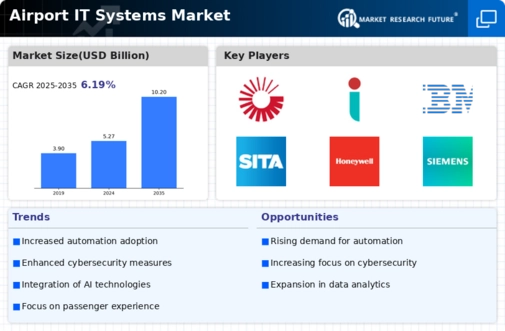Market Analysis
In-depth Analysis of Airport IT Systems Market Industry Landscape
The airport IT systems market is experiencing significant growth and transformation driven by technological advancements, increasing passenger volumes, and evolving customer expectations. Airport IT systems encompass a wide range of technologies and solutions designed to enhance operational efficiency, passenger experience, and security across all areas of airport operations. One notable trend in the market is the adoption of cloud-based and software-as-a-service (SaaS) solutions, which offer airports greater scalability, flexibility, and cost-effectiveness compared to traditional on-premises systems. Cloud-based IT systems enable airports to access and manage critical data and applications from anywhere, streamline operations, and adapt to changing passenger demands and industry regulations more effectively.
Moreover, advancements in artificial intelligence (AI), data analytics, and Internet of Things (IoT) technologies are driving innovation in airport IT systems, enabling airports to optimize resource allocation, improve predictive maintenance, and enhance security screening processes. AI-driven algorithms and machine learning models are being used to analyze vast amounts of data collected from sensors, surveillance cameras, and passenger feedback systems to identify patterns, detect anomalies, and predict potential operational issues or security threats in real-time. Additionally, IoT-enabled devices and smart sensors are being deployed throughout airports to monitor and manage critical infrastructure, such as runway lighting, baggage handling systems, and terminal facilities, improving operational efficiency and reducing downtime.
Furthermore, the market for airport IT systems is witnessing increasing demand for passenger-centric solutions that enhance the end-to-end travel experience and provide personalized services to passengers. With the rise of digitalization and mobile technology, passengers expect seamless and convenient interactions with airports from booking to boarding and beyond. As a result, airports are investing in digital passenger engagement platforms, mobile apps, and self-service kiosks that enable passengers to access real-time flight information, navigate airport facilities, and make bookings for ancillary services such as parking, lounge access, and retail purchases, enhancing overall satisfaction and loyalty.
Additionally, the market for airport IT systems is characterized by a growing focus on cybersecurity and data privacy as airports seek to protect sensitive passenger information and critical infrastructure from cyber threats and malicious attacks. With airports becoming increasingly interconnected and reliant on digital systems, they are vulnerable to cyberattacks that could disrupt operations, compromise safety, and compromise passenger data. As a result, airports are investing in robust cybersecurity solutions, threat detection systems, and employee training programs to strengthen their defenses against cyber threats and ensure compliance with data protection regulations such as GDPR and CCPA.
Moreover, the market for airport IT systems is experiencing increasing demand from emerging markets and non-aeronautical revenue streams as airports seek to diversify their sources of income and attract more passengers and airlines. With rapid urbanization, economic growth, and expanding middle-class populations in regions such as Asia-Pacific, Latin America, and the Middle East, there is a growing demand for airport infrastructure development and modernization to accommodate the increasing air travel demand. As a result, airports are investing in advanced IT systems and digital technologies to improve operational efficiency, enhance passenger experience, and generate additional revenue through retail, advertising, and other non-aeronautical services.









Leave a Comment